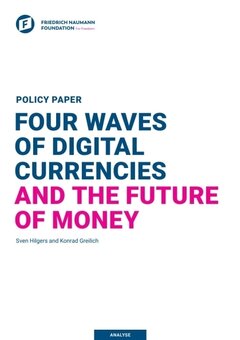POLICY PAPER
Four waves of the digital currency and the future money
The rise of digital currency has changed the financial world in record time. Established business models are facing new challenges. The development is often reduced to a single cryptocurrency: Bitcoin. But numerous other digital currencies have come into being since the appearance of this first crypto asset that enables direct transactions between private individuals. This policy paper outlines how different types of digital currencies have arisen in four waves and of-fers policy recommendations on how to shape their future development.
The diversity of digital currencies and their technological development can be seen in the first three waves. The authors classify developments by functionality, organizational form, governance, and source of value. With each wave, new functions are added or there is a shift in how the digital currencies can be utilized. A striking aspect of the emergence of digital currencies in the first three waves is the dominance of private actors without any major influence of public actors. Most of them are based on blockchain or distributed ledger technology, the technical details of which will be explained here as well.
The fourth wave is currently underway: In central bank digital currency (CBDC), central banks are developing an electronic form of established national or supranational currencies and are facing numerous critical decisions. This development will usher in a new currency era, in which different currencies and forms of currency come into far greater competition with one another in a single currency area.
Building on the analysis of the four waves, we offer suggestions about what sort of regulation makes sense for this new currency era and how digital central bank money can make a positive contribution. Whereas economic issues are the focus in the development of central bank digital currency in liberal democracies, there are many signs that CBDC can also be used for surveillance and social control in authoritarian, state-capitalist systems. Hence, what is at stake in the increasing systemic rivalry between liberal democracies and the latter is setting the standards for how digital currencies can be effectively used in the context of the rule of law. Overall, more openness to the diversity of digital currencies is needed, as well as to their potential for promoting the innovativeness of economies and the provision of stable money as a public good. A digital currency policy should thus be guided, above all, by the principles of innovation, inclusive- ness, stability, and freedom.

